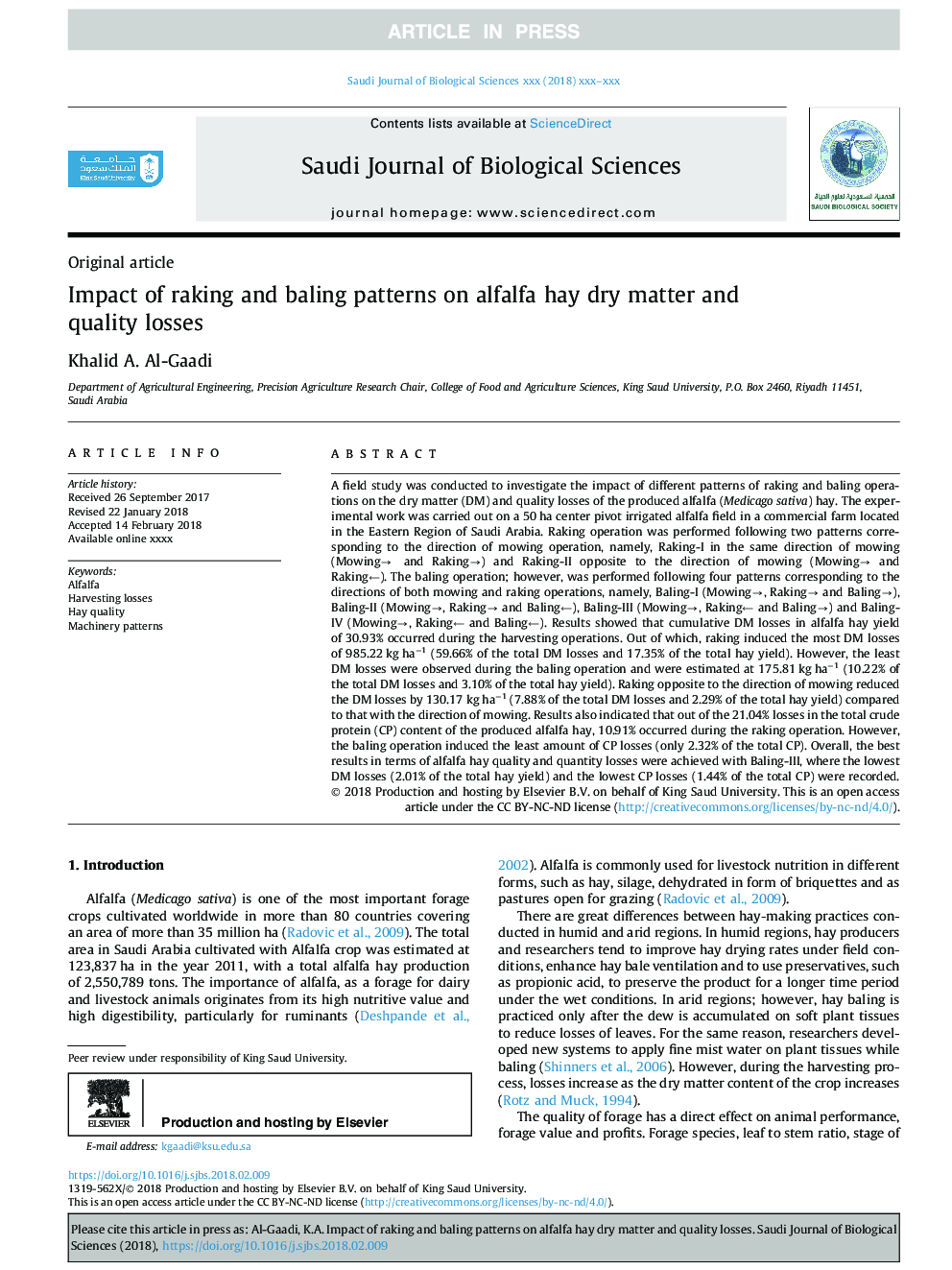| کد مقاله | کد نشریه | سال انتشار | مقاله انگلیسی | نسخه تمام متن |
|---|---|---|---|---|
| 8959265 | 1646302 | 2018 | 9 صفحه PDF | دانلود رایگان |
عنوان انگلیسی مقاله ISI
Impact of raking and baling patterns on alfalfa hay dry matter and quality losses
ترجمه فارسی عنوان
تاثیر الگوهای ریزش و پرت کردن بر خشکی یونجه و تلفات کیفیت
دانلود مقاله + سفارش ترجمه
دانلود مقاله ISI انگلیسی
رایگان برای ایرانیان
کلمات کلیدی
یونجه تلفات جمع آوری شده کیفیت هو الگوهای ماشین آلات،
موضوعات مرتبط
علوم زیستی و بیوفناوری
علوم محیط زیست
بوم شناسی
چکیده انگلیسی
A field study was conducted to investigate the impact of different patterns of raking and baling operations on the dry matter (DM) and quality losses of the produced alfalfa (Medicago sativa) hay. The experimental work was carried out on a 50â¯ha center pivot irrigated alfalfa field in a commercial farm located in the Eastern Region of Saudi Arabia. Raking operation was performed following two patterns corresponding to the direction of mowing operation, namely, Raking-I in the same direction of mowing (Mowingâ â¯and Rakingâ) and Raking-II opposite to the direction of mowing (Mowingâ and Rakingâ). The baling operation; however, was performed following four patterns corresponding to the directions of both mowing and raking operations, namely, Baling-I (Mowingâ, Rakingâ and Balingâ), Baling-II (Mowingâ, Rakingâ and Balingâ), Baling-III (Mowingâ, Rakingâ and Balingâ) and Baling-IV (Mowingâ, Rakingâ and Balingâ). Results showed that cumulative DM losses in alfalfa hay yield of 30.93% occurred during the harvesting operations. Out of which, raking induced the most DM losses of 985.22â¯kgâ¯haâ1 (59.66% of the total DM losses and 17.35% of the total hay yield). However, the least DM losses were observed during the baling operation and were estimated at 175.81â¯kgâ¯haâ1 (10.22% of the total DM losses and 3.10% of the total hay yield). Raking opposite to the direction of mowing reduced the DM losses by 130.17â¯kgâ¯haâ1 (7.88% of the total DM losses and 2.29% of the total hay yield) compared to that with the direction of mowing. Results also indicated that out of the 21.04% losses in the total crude protein (CP) content of the produced alfalfa hay, 10.91% occurred during the raking operation. However, the baling operation induced the least amount of CP losses (only 2.32% of the total CP). Overall, the best results in terms of alfalfa hay quality and quantity losses were achieved with Baling-III, where the lowest DM losses (2.01% of the total hay yield) and the lowest CP losses (1.44% of the total CP) were recorded.
ناشر
Database: Elsevier - ScienceDirect (ساینس دایرکت)
Journal: Saudi Journal of Biological Sciences - Volume 25, Issue 6, September 2018, Pages 1040-1048
Journal: Saudi Journal of Biological Sciences - Volume 25, Issue 6, September 2018, Pages 1040-1048
نویسندگان
Khalid A. Al-Gaadi,
